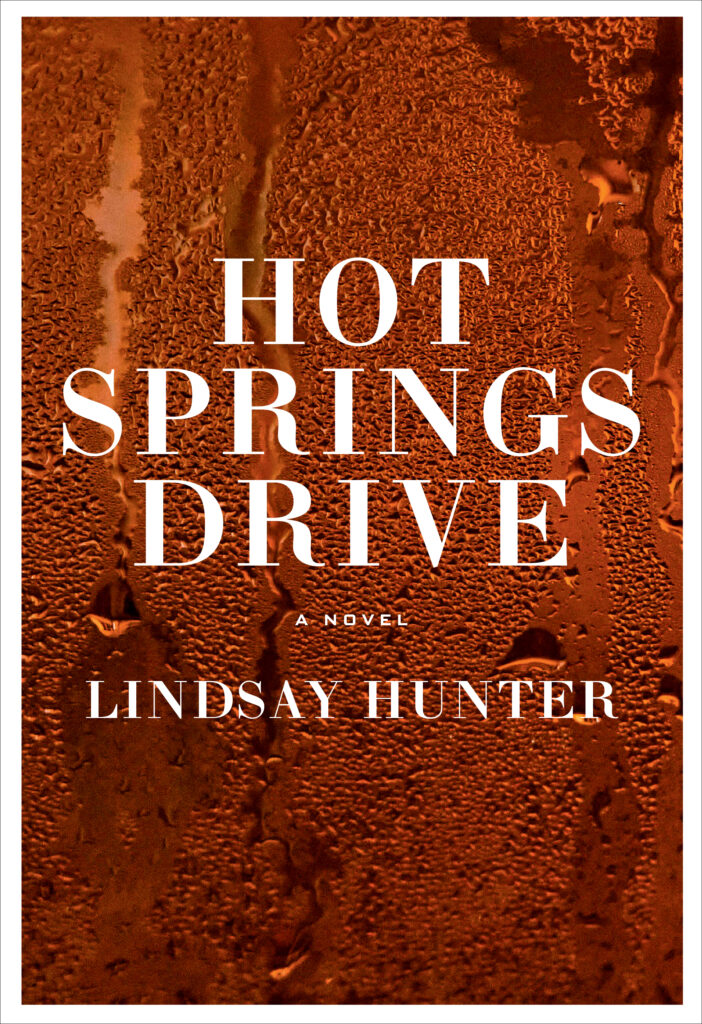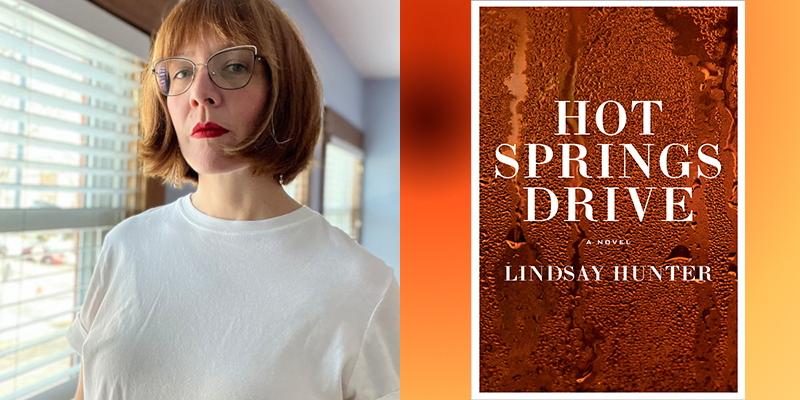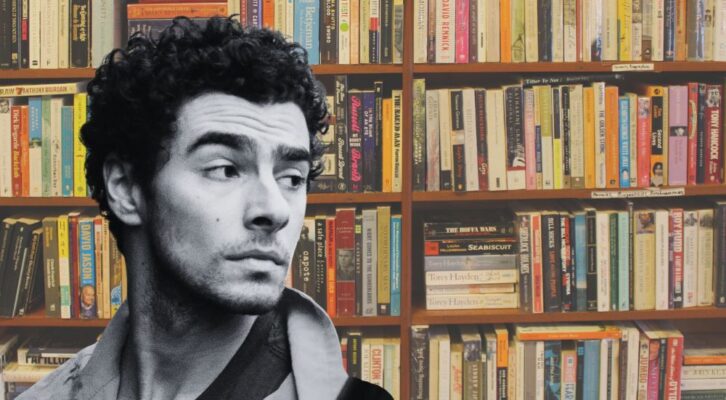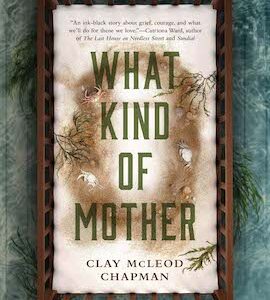Lindsay Hunter is the author of two story collections and three novels, including Eat Only When You’re Hungry. Her new novel, Hot Springs Drive, is forthcoming from Roxane Gay Books an imprint of Grove Atlantic on November 7th. In Hot Springs Drive, a close friendship between two women ends in the murder of one and the unraveling of the other, as she tries to balance between grief, justice, and guilt. Lindsay Hunter was kind enough to answer a few questions about the new book to accompany the cover reveal.
Tell us about your latest.
Hot Springs Drive is a novel that’s loosely based on a real murder that occurred. The crime itself is violent and bloody with–in my opinion–a surprise perpetrator, and I found myself compelled to write something about it. It’s a story about two women, best friends and neighbors, and how they and their families change over the years. It’s about growing up, befores and afters, love, desperation, sex, and a choice that has devastating consequences.
How did you balance between literary fiction and suspense when writing it?
You know, it’s interesting. This is my third novel–not to mention all the novels I’ve written that haven’t yet seen the light of day–and each time I have to teach myself all over again how to do it for the particular story I’m trying to tell. And this is such a different book for me, in terms of structure and storytelling. As I drafted, I felt almost feral. There was already this wild thing that I was building a novel around–this central violent act–and I was trying to detail the rippling effects of that violence, to capture all that matters beyond the horrific crime, and I did that by–this is what I told myself as I wrote–crafting these scraps that I would then stitch together in a crazy quilt sort of structure. I was trying to create a way to see it all at once. But! In revisions I found that I hadn’t left enough room for the reader, and I realized that, yes, while the effects are essential, a reader also needs details on the crime. The why, the how, the what. So I had to weave that in as I revised, while also holding close to my original intent of showing the aftermath of such an explosive event.
The interview continues below the cover.

Why are we so drawn to stories of suburban secrets?
Why do I love these grim, depressing stories of real pain? Am I a voyeur? Do I lack true empathy? I don’t think it’s any of those things. When it comes to something terrifying, violent, wrong, it’s human nature to ask, Why? And to gather as many details as we can in order to better understand what has happened. That knowledge is a comfort. We feel like we know the world a little better. I think these kinds of stories offer us a glimpse into a darkness that we all recognize, a darkness we’re all drawn to.
There’s also a story around every corner surrounding a crime. There’s the crime itself, there are the stories of the people involved, the town it happened in, the era in time, the detectives and their investigation, and on and on. It’s a narrative that expands exponentially, that offers answers which pose more questions. It’s a puzzle. We think, if I just assemble the pieces in the right way, I’ll understand. Instead, there’s just more to figure out. As a writer, and as a reader, that’s great material.
What did you want to explore about food, desire, and social control of women’s bodies in your new novel?
I think women are often pushed into a crevice they can’t fit into, a paradoxical riddle that has no correct answer. The pressure of the male gaze, maintaining one’s desirability, requires a kind of vigilance that may start to curdle. It’s getting better, but women and men alike work to protect the status quo that women should be attractive. I put lipstick on in my author photo. If I’m pretty, maybe more people will read my book! That kind of thinking.
In Jackie’s case, she seems to have lost herself. She’s forgotten she has agency. It’s not that things are out of control, more that Jackie has stopped trying to maintain control. She’s adrift. Speaking from personal experience, sometimes the way out is to find something that can be controlled, manipulated, shaped. Jackie, like so many women, finds that in her eating habits, in her body. She can get smaller and by doing so, she can receive the kinds of attention she wants. She can seek it out; she can take it. She can be wife, mother, friend and, most importantly, attractive. She can have it all. But, without revealing too much, she may have forgotten herself.
What’s the secret to crafting compelling characters who also happen to be terrible people?
I think humor helps a lot. Jackie is funny and quick, sometimes down and dirty. Offering glimpses of that “terrible” character from other characters’ points of view helps a lot too. Jackie was hard to read in my early drafts of the book, so angry she was nearly spitting. It felt very one-dimensional. In revisions I had to let in some light, to give her some depth beyond her rage.
My writing has often been about lending empathy to less-than-desirable characters. I say empathy, not sympathy. Empathy in terms of giving them authentic emotions, actions, agency, and letting the consequences of those actions have real effects. It’s something I fight to this day–letting my characters get into trouble without already having a way out for them. I’m learning to back my characters–and myself–into a corner, and to let the urgency of finding a way out guide my writing. It can be quite fun, once you get over the terror of it.
Who are some of your literary influences?
A.M. Homes is a big one. She owns darkly hilarious suburban narratives. Sara Levine comes to mind; I was lucky to study with her in grad school. Cruddy by Lynda Barry. Tana French. Gillian Flynn. Claire Fuller. I actually had a breakthrough when revising Hot Springs Drive as I read Elspeth Barker’s O, Caledonia. I now keep it on the desk I worked from as a good luck charm.
***


















